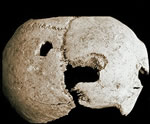 There is only one known gladiator graveyard. It’s in Ephesus, Turkey, and dates to around 200 AD. More than 60 gladiators are buried in a small cemetery on the road to the Temple of Artemis.
There is only one known gladiator graveyard. It’s in Ephesus, Turkey, and dates to around 200 AD. More than 60 gladiators are buried in a small cemetery on the road to the Temple of Artemis.
A study of the bones interred there has turned up some unexpected facts about the gladiatorial diet. No feasting on entire sides of beef whatsoever.
Contemporary accounts of gladiator life sometimes refer to the warriors as hordearii–literally, “barley men.” Grossschmidt and collaborator Fabian Kanz subjected bits of the bone to isotopic analysis, a technique that measures trace chemical elements such as calcium, strontium, and zinc, to see if they could find out why. They turned up some surprising results. Compared to the average inhabitant of Ephesus, gladiators ate more plants and very little animal protein. The vegetarian diet had nothing to do with poverty or animal rights. Gladiators, it seems, were fat. Consuming a lot of simple carbohydrates, such as barley, and legumes, like beans, was designed for survival in the arena. Packing in the carbs also packed on the pounds. “Gladiators needed subcutaneous fat,” Grossschmidt explains. “A fat cushion protects you from cut wounds and shields nerves and blood vessels in a fight.” Not only would a lean gladiator have been dead meat, he would have made for a bad show. Surface wounds “look more spectacular,” says Grossschmidt. “If I get wounded but just in the fatty layer, I can fight on,” he adds. “It doesn’t hurt much, and it looks great for the spectators.”
They made up for the inevitable calcium deficiency by taking vitamins. Since it was then instead of now, the supplements took on the form of something disgustingly unpalatable: brews of charred wood or bone ash. It did the trick, though. The bones found have enormously higher concentrations of calcium than the general population.
 The skull bones indicate gladiators received serious but non-fatal head blows often, despite the fact that all of the combat styles but one used helmets. Three of the skulls had holes from a trident in them.
The skull bones indicate gladiators received serious but non-fatal head blows often, despite the fact that all of the combat styles but one used helmets. Three of the skulls had holes from a trident in them.
The marks of a four-skewer dagger found in a knee bone explain how this weapon — heretofore only known from inscriptions — was actually used.